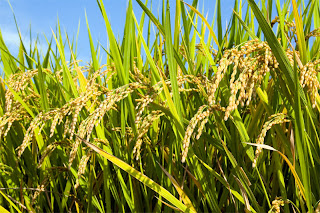About Me

- Pinoy Asian Fusion
- Surrey, Bc, Canada
- Tasty traditional recipes from the East. Many of the featured dishes offer inspired, easy and speedy choices for everyday meals.
Followers
RICE
As a grain, it is the most important staple food for a large part of the world's human population, especially in Asia and the West Indies.
______________________________________ Throughout Asia , the importance of the rice is underlined by the fact that in Chinese and other languages, there is no single word for rice, but many. The crop, grain, raw rice and cooked rice are all referred to by different terms, and the Chinese character fan for cooked rice has acquired a much wider meaning in colloquial speech; it is also synonymous with nourishment and good health.
Several kinds exist, which are classified as short-grain, medium-grain, or long-grain rice.
Long -grain sometimes labelled Patna, Blue bonnet, or Rexora is the type generally sold in America, but the other two types are available at most ordinary groceries now. Calrose, Blue Rose, Japan Rose, Kokuho, Nato, Magnolia and zenith are label names you will see for Medium-grain rice. California, Pearl and Colusa are Short-grain rice.
TYPES OF RICE
Patna rice gets its name from Patna in India. At one time, most of the long grain rice sold in Europe come from Patna, and the term was used loosely to mean any long grain rice. The custom persists in parts of America, but elsewhere Patna is used to describe a variety of long grain rice from the Bihar region of India.
Basmati rice a slender long grain rice that is grown in northern India, in the Punjab, in parts of Pakistan and foothills of the Himalayas. After harvesting it is aged for a year, which gives it a characteristic flavor and a light, fluffy texture. The grains are long and slender, and become even longer during cooking, basmati rice has a cooking effects on hot and spicy curries.
Thai Fragrant rice has a delicate but distinctive scent of jasmine, and is partcularly high prized.
Short-grained japonica (geng) rices are less fragrant, but tend to taste slightly sweeter than indicas. This type of rice is cultivated in northern China, Japan, Korea and surrounding areas. The rices' are higher in amylopectin than long grains, and are therefore more starchy. The grains cling together when cooked, which
makes them ideal for sushi and similar Japanese dishes.
Glutinous Rice also known as sweet or waxy rice is even more sticky than Japanese short grain rice. This endears it to South-east Asian cooks, as the cooked rice can be shaped or rolled, and is very easy to pick up with chopsticks. White glutinous rice , with its fat, opaque grains, is the most common type, but there is also a Black glutinous rice, which retains the husk and has a nutty flavor. Pinkish-red glutinous rice is cultivated on the banks of the Yangtze River and the Purple-black glutinous rice has recently been developed. Glutinous rice has a high sugar content, and is used in Japan for making Senbei (rice crackers) and Mochi (cakes), as well as sweet rice wines.
PREPARATION AND COOKING TECHNIQUES
There can never be a definitive recipe for cooking plain rice, because each requires individual treatment.
1. Put the dry rice in a large pan and rinse it under cold running water.
2. Pour in enough cold water to come 3/4 inch above the surface of rice. (in Asia the traditional way of measuring this is with the help of the index finger is touching the surfaces of the rice, the water level should just reach the first joint.
3. Put the pot without the lid over high heat and bring to a light boil. Stir the rice just once to ensure nothing is sticking to the bottom. Stirring any more than that will give you mushy rice. You may add a pinch of salt and teaspoon of vegetable oil.
4. When the water begins to bubble, put the lid on the lower heat to a bare simmer, this will probably be the lowest heat setting, but could be medium low depending on the stove.
5. Cook for 12-15 minutes, then turn off the heat and leave the rice to stand, tightly covered, for about 10 minutes. fluff up the rice with a fork before servings.
Subscribe to:
Comments (Atom)









0 comments:
Post a Comment